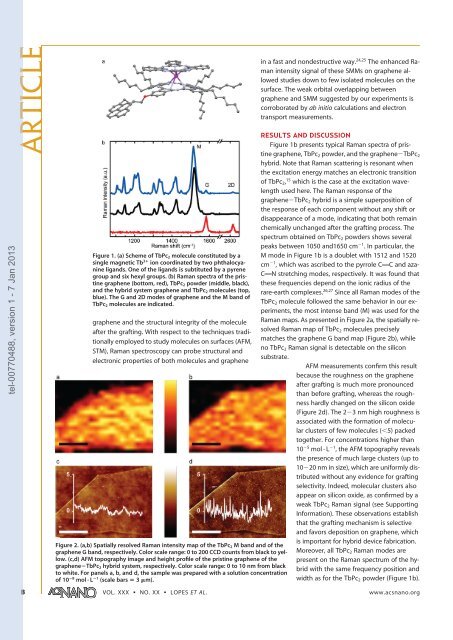Matias URDAMPILLETA - TEL
Matias URDAMPILLETA - TEL
Matias URDAMPILLETA - TEL
Create successful ePaper yourself
Turn your PDF publications into a flip-book with our unique Google optimized e-Paper software.
tel-00770488, version 1 - 7 Jan 2013<br />
ARTICLE<br />
B<br />
Figure 1. (a) Scheme of TbPc2 molecule constituted by a<br />
single magnetic Tb 3 ion coordinated by two phthalocyanine<br />
ligands. One of the ligands is subtituted by a pyrene<br />
group and six hexyl groups. (b) Raman spectra of the pristine<br />
graphene (bottom, red), TbPc2 powder (middle, black),<br />
and the hybrid system graphene and TbPc2 molecules (top,<br />
blue). The G and 2D modes of graphene and the M band of<br />
TbPc2 molecules are indicated.<br />
graphene and the structural integrity of the molecule<br />
after the grafting. With respect to the techniques traditionally<br />
employed to study molecules on surfaces (AFM,<br />
STM), Raman spectroscopy can probe structural and<br />
electronic properties of both molecules and graphene<br />
Figure 2. (a,b) Spatially resolved Raman intensity map of the TbPc2 M band and of the<br />
graphene G band, respectively. Color scale range: 0 to 200 CCD counts from black to yellow.<br />
(c,d) AFM topography image and height profile of the pristine graphene of the<br />
grapheneTbPc2 hybrid system, respectively. Color scale range: 0 to 10 nm from black<br />
to white. For panels a, b, and d, the sample was prepared with a solution concentration<br />
of 10 8 mol·L 1 (scale bars 3 m).<br />
in a fast and nondestructive way. 24,25 The enhanced Raman<br />
intensity signal of these SMMs on graphene allowed<br />
studies down to few isolated molecules on the<br />
surface. The weak orbital overlapping between<br />
graphene and SMM suggested by our experiments is<br />
corroborated by ab initio calculations and electron<br />
transport measurements.<br />
RESULTS AND DISCUSSION<br />
Figure 1b presents typical Raman spectra of pristine<br />
graphene, TbPc2 powder, and the grapheneTbPc2<br />
hybrid. Note that Raman scattering is resonant when<br />
the excitation energy matches an electronic transition<br />
of TbPc2, 15 which is the case at the excitation wavelength<br />
used here. The Raman response of the<br />
grapheneTbPc2 hybrid is a simple superposition of<br />
the response of each component without any shift or<br />
disappearance of a mode, indicating that both remain<br />
chemically unchanged after the grafting process. The<br />
spectrum obtained on TbPc2 powders shows several<br />
peaks between 1050 and1650 cm 1 . In particular, the<br />
M mode in Figure 1b is a doublet with 1512 and 1520<br />
cm 1 , which was ascribed to the pyrrole CAC and aza-<br />
CAN stretching modes, respectively. It was found that<br />
these frequencies depend on the ionic radius of the<br />
rare-earth complexes. 26,27 Since all Raman modes of the<br />
TbPc2 molecule followed the same behavior in our experiments,<br />
the most intense band (M) was used for the<br />
Raman maps. As presented in Figure 2a, the spatially resolved<br />
Raman map of TbPc2 molecules precisely<br />
matches the graphene G band map (Figure 2b), while<br />
no TbPc2 Raman signal is detectable on the silicon<br />
substrate.<br />
AFM measurements confirm this result<br />
because the roughness on the graphene<br />
after grafting is much more pronounced<br />
than before grafting, whereas the roughness<br />
hardly changed on the silicon oxide<br />
(Figure 2d). The 23 nm high roughness is<br />
associated with the formation of molecular<br />
clusters of few molecules (5) packed<br />
together. For concentrations higher than<br />
10 5 mol·L 1 , the AFM topography reveals<br />
the presence of much large clusters (up to<br />
1020 nm in size), which are uniformly distributed<br />
without any evidence for grafting<br />
selectivity. Indeed, molecular clusters also<br />
appear on silicon oxide, as confirmed by a<br />
weak TbPc2 Raman signal (see Supporting<br />
Information). These observations establish<br />
that the grafting mechanism is selective<br />
and favors deposition on graphene, which<br />
is important for hybrid device fabrication.<br />
Moreover, all TbPc2 Raman modes are<br />
present on the Raman spectrum of the hybrid<br />
with the same frequency position and<br />
width as for the TbPc2 powder (Figure 1b).<br />
VOL. XXX ▪ NO. XX ▪ LOPES ET AL. www.acsnano.org

















